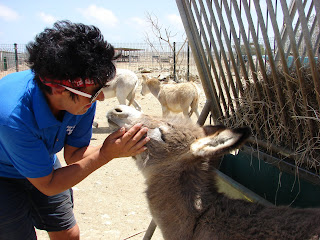 The Caribbean island of Bonaire is 50 miles north of Venezuela and 86 miles east of Aruba. The best thing is that it is out of the hurricane belt so any time of the year is a good time to visit. There is plenty of sunshine year round.
The Caribbean island of Bonaire is 50 miles north of Venezuela and 86 miles east of Aruba. The best thing is that it is out of the hurricane belt so any time of the year is a good time to visit. There is plenty of sunshine year round. 1. Kralendijk: Bonaire’s capital, Kralendijk, is a colorful, port city with a population of 4000 making for a great walkabout. The architecture has been well preserved. Start at the Visitor’s Center to pick up a free walking tour brochure. Visit Fort Orange, the quaint churches and Queen Wilhemina Park.
2. History: The original inhabitants were the Caiquetios, a branch
of the Arawak Indians. Rock paintings and petroglyphs from that time have survived in several of the island’s caves. The first Europeans to claim the island were the Spanish and then the Dutch. Near the town of Rincon is the newly upgraded cultural center, Mangazina di Rei (The Storehouse of the King) where slaves were given provisions.
3. Diving: Frommer’s rates Bonaire number one when it comes to scuba diving. The island is surrounded by reefs that are pristine and easily accessible. Go out on a dive boat or enter from the shore where the access to the sea is clearly marked by bright yellow painted rocks that names the dive site.
4. Catching the wind: It is almost always windy on Bonaire
 making it a mecca for wind surfers and kite boarders. The clear water of Lac Bay is the perfect place for beginners to learn and for freestylers who want to hone their skills. Kite boarding takes place on Atlantis Beach.
making it a mecca for wind surfers and kite boarders. The clear water of Lac Bay is the perfect place for beginners to learn and for freestylers who want to hone their skills. Kite boarding takes place on Atlantis Beach. 5. Salt: The salt of Bonaire is a natural product made by the evaporation of seawater by the sunshine and wind. The brine is pumped into crystallizers where it remains for about a year during which the salty water turns green and then a beautiful rose. When it is ready to harvest it is piled in large mountains of salt. Nearby are replicas of the small huts for the slaves who at one time worked in the salt industry.
6. Donkeys: The Spanish brought the donkeys to the island to
use as draft animals. In 1993 Dutch Nationals, Marina Melis, and her husband, Ed Koopman, established a donkey sanctuary on Bonaire for sick, wounded and orphaned donkeys. Visitors are welcome to visit and interact with the donkeys for a nominal fee.
7. Birds: With over 200 species Bonarie is a bird-lover’s paradise. There are migrating birds, seabirds, shore birds, and land birds but the iconic symbol of Bonaire is the elegant pink flamingo. Bonaire is only one of four areas in the world where flamingos breed.
8. Shopping: There are
several art shops in Kralendij. There is a regularly scheduled art and craft market in the city. Paintings depicting Bonaire scenes, or a stone painted yellow with the name of your favorite dive site, and a piece of driftwood art make great remembrances of Bonaire
9. Tours: There are a plethora of tours for those who want to bike, hike, kayak, fish, go caving, have an off-road adventure, go horseback riding, repel, plus Segway tours, and a city tour in a luxurious tuk-tuk. A glass-bottom boat tour is perfect for those who want to see the coral reef without getting wet.
 10. Wining and dining: Those who want to try something new should head to the historic village of Rincon. Cadushy Distillery uses the cactus that is found all over the island to make cactus liqueur in a variety of flavors. Posada Para Mira, also in Rincon, is one place to sample local fare such at goat stew.
10. Wining and dining: Those who want to try something new should head to the historic village of Rincon. Cadushy Distillery uses the cactus that is found all over the island to make cactus liqueur in a variety of flavors. Posada Para Mira, also in Rincon, is one place to sample local fare such at goat stew. 






